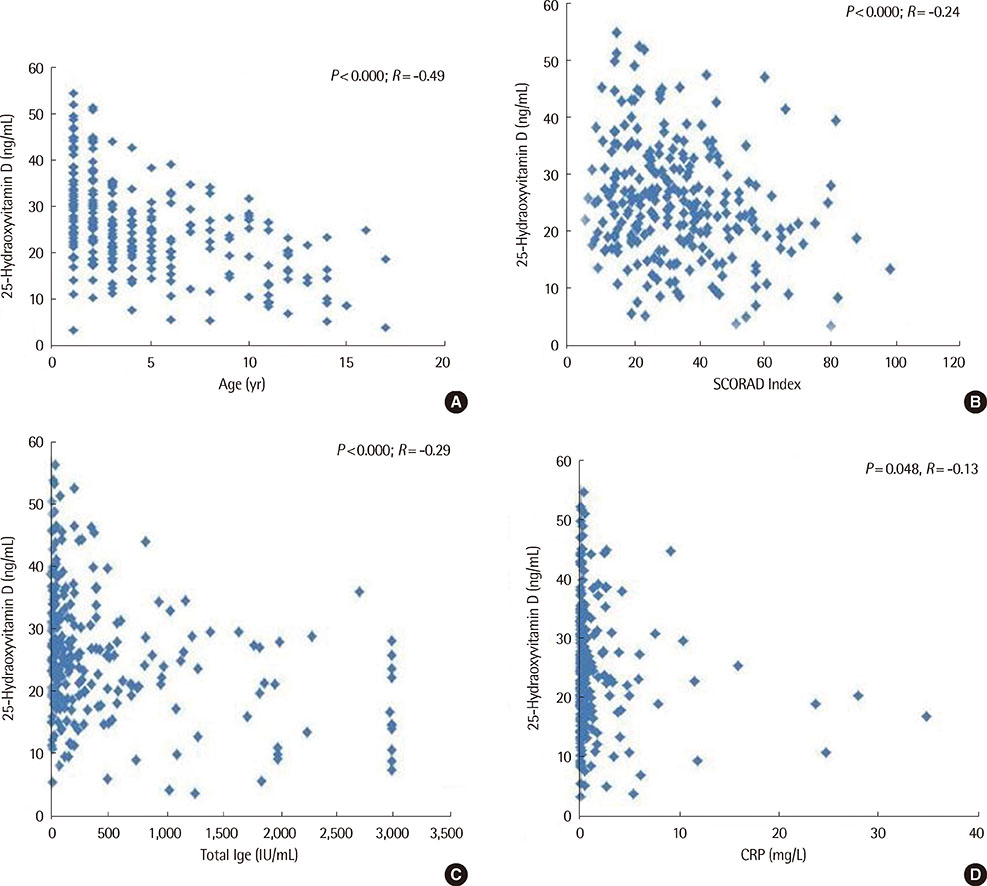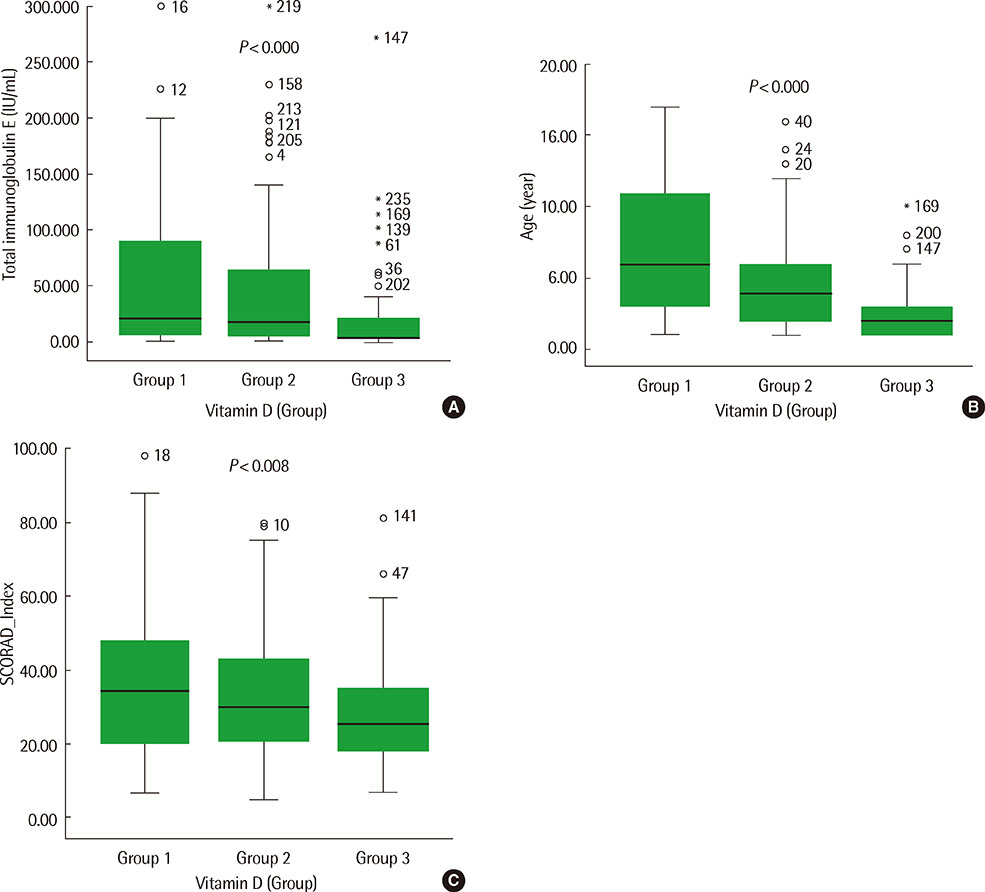Allergy Asthma Respir Dis.
2014 May;2(2):114-121. 10.4168/aard.2014.2.2.114.
Correlation between serum 25-hydroxyvitamin D levels and severity of atopic dermatitis in children
- Affiliations
-
- 1Department of Pediatrics, Busan St. Mary's Hospital, Busan, Korea. sbdph1@daum.net
- KMID: 2261746
- DOI: http://doi.org/10.4168/aard.2014.2.2.114
Abstract
- PURPOSE
Vitamin D deficiency has been suggested to play a role in the pathogenesis of atopic dermatitis. In addition, inverse correlationship between serum 25-hydroxyvitamin D concentration and severity of atopic dermatitis has been suggested.
METHODS
Clinical and laboratory parameters including serum 25-hydroxyvitamin D level and serum total IgE of 251 patients with atopic dermatitis who were 13 months to 18 years were measured. Severity of atopic dermatitis was assessed with SCORing Atopic Dermatitis (SCORAD) index. Statistical analysis was performed using Pearson correlation coefficient, one-way analysis of variance test and chi-square test.
RESULTS
Among 251 patients, vitamin D deficiency (25-hydroxyvitamin D<20 ng/mL, group 1) was present in 76 subjects (30.3%), vitamin D insufficiency (25-hydroxyvitamin D 20-29 ng/mL, group 2) was present in 101 (40.2%), and vitamin D sufficiency (25-hydroxyvitamin D> or =30 ng/mL, group 3) was present in 74 (29.5%). There was a statistically significant inverse correlation between serum concentration of 25-hydroxyvitamin D and values of SCORAD index (R=-0.24, P<0.000). Serum concentration of 25-hydroxyvitamin D were inversely correlated with total IgE (R=-0.29, P<0.000), and age (R=-0.49, P<0.000).
CONCLUSION
The results from this study indicate that serum concentration of 25-hydroxyvitamin D is inversely correlated with clinical severity of atopic dermatitis in children.
Keyword
MeSH Terms
Figure
Cited by 2 articles
-
Evaluation of vitamin D in patients with asthma
Jae-Woo Jung, Hye-Ryun Kang
Allergy Asthma Respir Dis. 2016;4(1):1-3. doi: 10.4168/aard.2016.4.1.1.Current research status of pediatric atopic dermatitis in Korea
Bok Yang Pyun
Allergy Asthma Respir Dis. 2018;6(Suppl 1):S40-S43. doi: 10.4168/aard.2018.6.S1.S40.
Reference
-
1. Spergel JM. Epidemiology of atopic dermatitis and atopic march in children. Immunol Allergy Clin North Am. 2010; 30:269–280.
Article2. Nam SY, Yoon HS, Kim WK. Prevalence of allergic disease in kindergarten age children in Korea. Pediatr Allergy Respir Dis. 2005; 15:439–445.3. Bieber T. Atopic dermatitis. N Engl J Med. 2008; 358:1483–1494.
Article4. Benson AA, Toh JA, Vernon N, Jariwala SP. The role of vitamin D in the immunopathogenesis of allergic skin diseases. Allergy. 2012; 67:296–301.
Article5. Roider E, Ruzicka T, Schauber J. Vitamin d, the cutaneous barrier, antimicrobial peptides and allergies: is there a link? Allergy Asthma Immunol Res. 2013; 5:119–128.
Article6. Mutgi K, Koo J. Update on the role of systemic vitamin d in atopic dermatitis. Pediatr Dermatol. 2013; 30:303–307.
Article7. Bikle DD. Vitamin D metabolism and function in the skin. Mol Cell Endocrinol. 2011; 347:80–89.
Article8. Wang TT, Nestel FP, Bourdeau V, Nagai Y, Wang Q, Liao J, et al. Cutting edge: 1,25-dihydroxyvitamin D3 is a direct inducer of antimicrobial peptide gene expression. J Immunol. 2004; 173:2909–2912.
Article9. Oren E, Banerji A, Camargo CA Jr. Vitamin D and atopic disorders in an obese population screened for vitamin D deficiency. J Allergy Clin Immunol. 2008; 121:533–534.
Article10. Miyake Y, Sasaki S, Tanaka K, Hirota Y. Dairy food, calcium and vitamin D intake in pregnancy, and wheeze and eczema in infants. Eur Respir J. 2010; 35:1228–1234.
Article11. Back O, Blomquist HK, Hernell O, Stenberg B. Does vitamin D intake during infancy promote the development of atopic allergy? Acta Derm Venereol. 2009; 89:28–32.
Article12. Erkkola M, Kaila M, Nwaru BI, Kronberg-Kippila C, Ahonen S, Nevalainen J, et al. Maternal vitamin D intake during pregnancy is inversely associated with asthma and allergic rhinitis in 5-year-old children. Clin Exp Allergy. 2009; 39:875–882.
Article13. Nwaru BI, Ahonen S, Kaila M, Erkkola M, Haapala AM, Kronberg-Kippila C, et al. Maternal diet during pregnancy and allergic sensitization in the offspring by 5 yrs of age: a prospective cohort study. Pediatr Allergy Immunol. 2010; 21(1 Pt 1):29–37.
Article14. Ginde AA, Liu MC, Camargo CA Jr. Demographic differences and trends of vitamin D insufficiency in the US population, 1988-2004. Arch Intern Med. 2009; 169:626–632.
Article15. Hanifin JM, Raika G. Diagnostic features of atopic dermatitis. Acta Derm Venereol Suppl (Stockh). 1980; 92:44–47.16. Halicioglu O, Sutcuoglu S, Koc F, Yildiz O, Akman SA, Aksit S. Vitamin D status of exclusively breastfed 4-month-old infants supplemented during different seasons. Pediatrics. 2012; 130:e921–e927.
Article17. Oranje AP, Glazenburg EJ, Wolkerstorfer A, de Waard-van der Spek FB. Practical issues on interpretation of scoring atopic dermatitis: the SCORAD index, objective SCORAD and the three-item severity score. Br J Dermatol. 2007; 157:645–648.
Article18. Rosen CJ. Clinical practice. Vitamin D insufficiency. N Engl J Med. 2011; 364:248–254.19. Bischoff-Ferrari HA, Giovannucci E, Willett WC, Dietrich T, Dawson-Hughes B. Estimation of optimal serum concentrations of 25-hydroxyvitamin D for multiple health outcomes. Am J Clin Nutr. 2006; 84:18–28.
Article20. Bogaczewicz J, Sysa-Jedrzejowska A, Arkuszewska C, Zabek J, Kontny E, McCauliffe D, et al. Vitamin D status in systemic lupus erythematosus patients and its association with selected clinical and laboratory parameters. Lupus. 2012; 21:477–484.
Article21. Manchanda PK, Bid HK. Vitamin D receptor and type 2 diabetes mellitus: Growing therapeutic opportunities. Indian J Hum Genet. 2012; 18:274–275.
Article22. Ong PY, Ohtake T, Brandt C, Strickland I, Boguniewicz M, Ganz T, et al. Endogenous antimicrobial peptides and skin infections in atopic dermatitis. N Engl J Med. 2002; 347:1151–1160.
Article23. Hata TR, Kotol P, Jackson M, Nguyen M, Paik A, Udall D, et al. Administration of oral vitamin D induces cathelicidin production in atopic individuals. J Allergy Clin Immunol. 2008; 122:829–831.
Article24. Tsoukas CD, Provvedini DM, Manolagas SC. 1,25-dihydroxyvitamin D3: a novel immunoregulatory hormone. Science. 1984; 224:1438–1440.
Article25. Mahon BD, Wittke A, Weaver V, Cantorna MT. The targets of vitamin D depend on the differentiation and activation status of CD4 positive T cells. J Cell Biochem. 2003; 89:922–932.
Article26. Peroni DG, Piacentini GL, Cametti E, Chinellato I, Boner AL. Correlation between serum 25-hydroxyvitamin D levels and severity of atopic dermatitis in children. Br J Dermatol. 2011; 164:1078–1082.
Article27. Chiu YE, Havens PL, Siegel DH, Ali O, Wang T, Holland KE, et al. Serum 25-hydroxyvitamin D concentration does not correlate with atopic dermatitis severity. J Am Acad Dermatol. 2013; 69:40–46.
Article28. Hilger J, Friedel A, Herr R, Rausch T, Roos F, Wahl DA, et al. A systematic review of vitamin D status in populations worldwide. Br J Nutr. 2014; 111:23–45.
Article29. Choi EY. 25(OH)D status and demographic and lifestyle determinants of 25(OH)D among Korean adults. Asia Pac J Clin Nutr. 2012; 21:526–535.30. Choi HS, Oh HJ, Choi H, Choi WH, Kim JG, Kim KM, et al. Vitamin D insufficiency in Korea--a greater threat to younger generation: the Korea National Health and Nutrition Examination Survey (KNHANES) 2008. J Clin Endocrinol Metab. 2011; 96:643–651.
Article31. Weiland SK, Husing A, Strachan DP, Rzehak P, Pearce N. ISAAC Phase One Study Group. Climate and the prevalence of symptoms of asthma, allergic rhinitis, and atopic eczema in children. Occup Environ Med. 2004; 61:609–615.
Article32. Vahavihu K, Ala-Houhala M, Peric M, Karisola P, Kautiainen H, Hasan T, et al. Narrowband ultraviolet B treatment improves vitamin D balance and alters antimicrobial peptide expression in skin lesions of psoriasis and atopic dermatitis. Br J Dermatol. 2010; 163:321–328.
Article33. Vähävihu K, Ylianttila L, Kautiainen H, Viljakainen H, Lamberg-Allardt C, Hasan T, et al. Narrowband ultraviolet B course improves vitamin D balance in women in winter. Br J Dermatol. 2010; 162:848–853.
Article34. Ala-Houhala MJ, Vahavihu K, Hasan T, Kautiainen H, Ylianttila L, Viljakainen HT, et al. Comparison of narrowband ultraviolet B exposure and oral vitamin D substitution on serum 25-hydroxyvitamin D concentration. Br J Dermatol. 2012; 167:160–164.
Article35. Brehm JM, Celedon JC, Soto-Quiros ME, Avila L, Hunninghake GM, Forno E, et al. Serum vitamin D levels and markers of severity of childhood asthma in Costa Rica. Am J Respir Crit Care Med. 2009; 179:765–771.
Article36. Leyden JJ, Marples RR, Kligman AM. Staphylococcus aureus in the lesions of atopic dermatitis. Br J Dermatol. 1974; 90:525–530.
Article37. Kim YH, Lee ES, Kim JS, Kim MJ, Jung JA, Yang S, et al. The effect of skin-colonizing Staphylococcus aureus and Its exotoxins on childhood atopic dermatitis. Pediatr Allergy Respir Dis. 2006; 16:162–170.38. Matheson EM, Mainous AG 3rd, Hueston WJ, Diaz VA, Everett CJ. Vitamin D and methicillin-resistant Staphylococcus aureus nasal carriage. Scand J Infect Dis. 2010; 42:455–460.
Article39. Sidbury R, Sullivan AF, Thadhani RI, Camargo CA Jr. Randomized controlled trial of vitamin D supplementation for winter-related atopic dermatitis in Boston: a pilot study. Br J Dermatol. 2008; 159:245–247.
Article40. Hata TR, Audish D, Kotol P, Coda A, Kabigting F, Miller J, et al. A randomized controlled double-blind investigation of the effects of vitamin D dietary supplementation in subjects with atopic dermatitis. J Eur Acad Dermatol Venereol. 2013; May. 03. [Epub]. http://dx.doi.org/10.1111/jdv.12176.
Article
- Full Text Links
- Actions
-
Cited
- CITED
-
- Close
- Share
- Similar articles
-
- Vitamin D Status and Its Relationship with Disease Severity/activity in Patients with Atopic Dermatitis, Psoriasis, and Chronic Idiopathic Urticaria in Korea
- Correlation between serum 25-hydroxyvitamin D3 and the severity of atopic dermatitis in children with allergic or nonallergenic sensitization
- Vitamin D Status and Its Association with the SCORAD Score and Serum LL-37 Level in Korean Adults and Children with Atopic Dermatitis
- Relationship between serum interleukin-31/25-hydroxyvitamin D levels and the severity of atopic dermatitis in children
- Relationship between serum 25-hydroxyvitamin D and interleukin-31 levels, and the severity of atopic dermatitis in children



